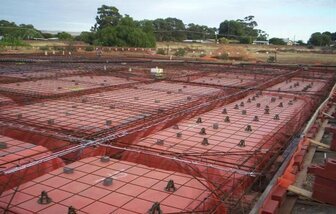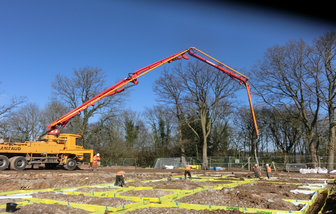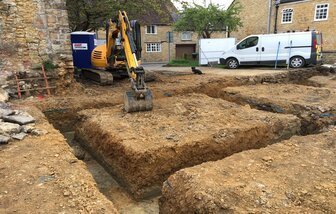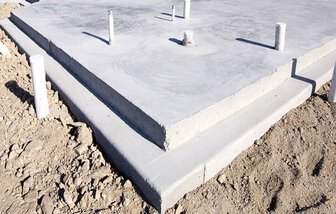Foundation building regulations
Understanding the Latest Building Regulations for Foundations in the UK
When it comes to building a new construction in the UK, it is important to be aware of the latest building regulations for foundations.
The regulations are designed to ensure that construction projects are structurally sound and meet certain safety standards. This includes the use of appropriate foundation systems such as concrete foundation, pile foundations, or strip foundations, depending on the ground conditions and load bearing walls.
A structural engineer can help determine the best foundation system for a new building, while the building inspector will check that the foundation widths, pour concrete, and damp-proof membrane comply with the approved document.
Other factors such as adjacent structures and ground movement must also be considered. These regulations apply to residential buildings including low-rise buildings and other domestic projects.
It is important to follow these regulations to ensure a safe and durable construction that meets building control requirements and is properly insulated.

Building control is a critical aspect of the construction process in the UK, and complying with foundation regulations is essential to ensure a successful build. Building regulations for foundations cover a wide range of factors, including ground conditions, load-bearing walls, and foundation widths, among others.
A structural engineer can provide expert guidance on the appropriate foundation type for a specific project, such as deep foundations or strip foundations for low-rise buildings. Building control ensures that the construction process adheres to the approved document and that the necessary inspections are carried out by a building inspector.
Compliance with foundation regulations is vital for ensuring the safety and stability of residential buildings and preventing ground movement, dampness, and other problems. Building control also oversees the installation of damp proof membranes and insulation, which are essential for maintaining energy efficiency and preventing heat loss.
By complying with building regulations for foundations, builders can ensure a successful construction project that meets the highest standards of safety and quality.
Meeting the foundation requirements of UK building regulations is essential for any construction project. To comply with the regulations, builders and engineers need to understand the guidelines provided in the approved documents, which cover topics such as damp proofing, insulation, and foundation widths.
A structural engineer can help determine the best type of foundation for the project based on factors like ground conditions, adjacent structures, and load-bearing walls. Strip foundations are commonly used for low-rise residential buildings, while pile foundations are often necessary for larger and more complex structures. It is important to pour concrete to the right depth and use strip footings to prevent ground movement. Building inspectors will check the foundation work, and failing to comply with the building regulations can result in costly delays and legal issues.
By following the guidelines provided in the building regulations, builders can ensure their projects meet the required standards and are safe and structurally sound.
Before starting any construction project in the UK, it is important to understand the building foundation regulations. Building regulations for foundations are in place to ensure that structures are safe, stable, and durable. These regulations cover a wide range of factors, including the depth and width of foundations, the use of concrete or other materials, and the need for damp proof membranes.
It is important to work with a structural engineer who can design a foundation system that meets the regulations and can support the load-bearing walls of the structure. Ground conditions must also be considered when designing foundations, as different soil types require diverse types of foundations. Other factors, such as adjacent structures and ground movement, must also be considered. By complying with the building foundation regulations, your construction project can be completed safely and successfully.
When it comes to building foundation design and construction in the UK, it is essential to understand and navigate the building regulations that govern this process.
HSE (Health & Safety Executive) regulations cover a wide range of topics, including concrete foundation construction, ground conditions, and the use of structural engineers. For new buildings, regulations require that foundations be designed and constructed to support the load-bearing walls and floors. The depth and width of foundations must also comply with building regulations and specific site conditions such as ground level and soil type.
In addition, regulations dictate the use of approved documents and the installation of damp proof membranes for residential buildings. Building inspectors must approve the foundation design and construction, and compliance with these regulations is crucial to ensure a successful construction project. With the help of a professional construction team experienced in navigating building regulations, you can ensure that your foundation design and construction meet all necessary requirements in the UK.
Ensuring compliance with building regulations for foundations is crucial to the success of any construction project in the UK. Building regulations exist to ensure the safety and structural integrity of buildings, and failing to comply with them can result in costly fines and even the demolition of the building.
To ensure compliance, it is important to work with a structural engineer who is familiar with the latest building regulations and can design a foundation system that meets the specific requirements of the project. It is also important to consider factors such as ground conditions, adjacent structures, and ground movement when designing and constructing foundations.
Regular inspections by a building inspector can ensure that the foundation work is being carried out to the approved document and that any issues are identified and addressed before they become major problems. By following these steps and working closely with building control, you can ensure that your construction project meets all necessary building regulations for foundations in the UK.
As the construction industry continues to evolve, so do the building regulations in the UK. In 2021, there are several changes to the foundation regulations that construction companies need to be aware of. One of the main changes is the updated Approved Document A, which now includes guidance on the use of modern methods of construction for foundations, such as precast concrete and modular foundations.
Additionally, there are changes to the requirements for ground conditions and soil surveys, which now need to be carried out by a qualified professional. It is also important to note that there are changes to the requirements for damp proofing and insulation, as well as new guidelines for strip foundations and pile foundations.
To ensure compliance with the latest foundation regulations, it’s crucial for construction companies to work closely with structural engineers, building inspectors, and other professionals to ensure their projects meet the highest standards of safety and quality.
Building regulations play a crucial role in determining the depth and design of foundations in construction projects in the UK. As a result, it is essential to understand how these regulations impact foundation construction. Building regulations cover a range of aspects, such as load-bearing capacity, ground conditions, and building types, among other factors.
For instance, the type of foundation required for a new building will differ from that of a residential building, and the foundation depth for a low-rise building will be different from that of a high-rise building. It is therefore important to work with a structural engineer and ensure that the foundation design and construction comply with the building regulations set out in the approved document. Failure to comply with these regulations may result in costly consequences, such as damage to adjacent structures, poor insulation, or even the building’s demolition.
Foundations for the Empire State Building?
The Empire State Building, standing tall and proud in the heart of New York City, is an iconic landmark that has captivated people around the world for
Why building foundations are necessary?
Foundations are the bedrock of any building, be it a humble house or towering high-rise buildings. They have the vital job of transferring the entire weight
The perfect concrete pour for your construction project
We will discuss the dos and don’ts of concreting for your next construction project, covering aspects such as the concrete mix, pouring, curing process
What is a raft foundation?
Raft foundations are a popular choice for many construction projects, providing a stable and durable base for buildings. Explore the benefits of raft foundations, the construction process
What is a building foundation?
A building foundation is the lowermost part of a structure that is in direct contact with the ground. It is designed to distribute the weight of the building evenly and transfer it to the underlying soil or rock.
Types of building foundations
This article discusses the different types of building foundations in the UK, including strip foundations, raft foundations, piled foundations, trenchfill foundations, pad foundations, caisson foundations
How long do foundations take to cure?
A step-by-step guide is required, starting with marking lines to indicate where to dig the foundations trenches. After landscaping, shuttering, reinforced with timber, must be used
How to set out building foundations
Setting out the building foundations of a construction project is a critical stage, and it requires the use of specialised tools and materials. In the UK, the most common tools
How deep do building foundations need to be?
Building foundations are a critical component of any construction project in the UK, and it is important to ensure that they are constructed to the required depth.
Foundation building regulations
The regulations are designed to ensure that construction projects are structurally sound and meet certain safety standards. This includes the use of appropriate foundation systems
What is a building slab?
Building slabs are an essential component of construction projects in the UK. They provide a solid and stable foundation for structures, distributing the weight evenly across the ground. This article discusses the types of building slabs commonly
Why building foundations fail?
Understanding the factors that contribute to building foundation failures in the UK, such as soil conditions, poor drainage, tree roots, construction errors, subsidence, and the age of buildings.
Ready to start your project?
Let's Work Together
To get started, for general enquiries simply complete the form below. Provide us with your project details, and our team will review your requirements. We will then get back to you with a customised solution that fits your needs. Whether you have a small-scale project or a large-scale development, we have the expertise and resources to handle it. Once we have received your submission, you will receive a confirmation email (Please check all your email boxes)
If you prefer, and have a project in mind and seeking a price you can also send us your project documents and any photographs directly to Price@totalregen.co.uk. We will carefully examine your documents and provide you with a competitive quote together with a timescale from inception through to completion for your project.












